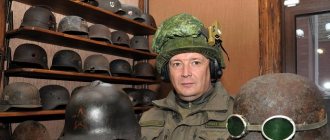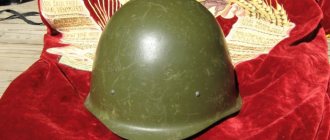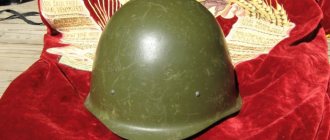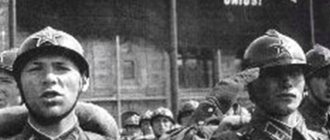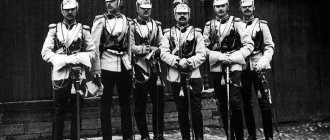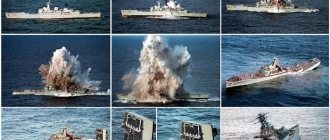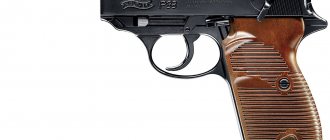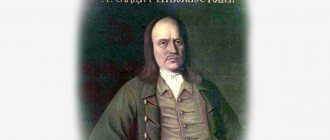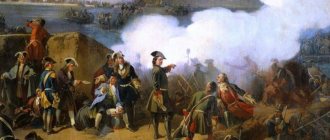Army protective helmets (ZH) are a reminder of the era of knights. They remained an almost unchanged part of the combat armor. If the cuirass was transformed into a bulletproof vest, which does not at all resemble the combat military armor of a knight, then iron helmets were produced until recently.
Although there was a time in military history when soldiers wore headgear instead of protective helmets, eventually necessity forced the military authorities to return this part of the armor to service.
The appearance of combat helmets in France
Until the outbreak of the First World War, soldiers of European countries did without protective helmets. The army abandoned armor long ago, so a helmet protecting the head was considered an element of ancient armor that had no place in the modern army. However, the First World War, which was unofficially called the “trench war,” showed that abandoning soldiers’ helmets was a rash decision.
Since it was necessary to stick out of the trenches, the soldiers’ heads were the first to feel how bad they felt without reliable protection. Most soldier deaths occurred from hits to the head. Seeing the monstrous losses of personnel that occur in war every day, the generals of European countries became seriously worried.
The first special-purpose helmets were developed in France. Before their appearance, French soldiers wore cloth caps, which could only protect their heads from bad weather. The first French helmet was called “Adriana” and began to be mass-produced already in 1915. It was not one-piece and consisted of the following parts:
- Cap;
- Comb;
- Skirts.
Immediately after the appearance of helmets, the losses of the French army decreased significantly. For example, the total number of wounded decreased by 30%, and those killed by 12-13%. It is worth considering the important fact that the French helmet was not intended to protect against bullets. He, of course, could ricochet a bullet that hit him along a lateral trajectory, but he could not withstand a direct hit. But shrapnel and fragments from grenades did not penetrate it.
Seeing the unexpected success in “reanimating” such a seemingly outdated element of protection as a helmet, the allied countries hastened to purchase huge quantities of “Adrian” for their armies. The following countries have purchased such protection:
- Russia;
- Romania;
- Italy;
- Portugal;
- Great Britain.
All of the above countries, except England, were very pleased with the protective properties of French helmets.
How did the concept of “helmet” come about?
A special piece of clothing designed to protect a warrior’s head during battle was originally called a helmet. Since it was a continuation of the armor and was also made of iron, the military command included it in the standard combat kit under the official name “steel helmet” and recognized it as an effective means of individual protection for a fighter.
With the advent of various types of troops and the improvement of military craft, helmets began to be modernized. The products were dome-shaped. Steel was used to make them. But history knows examples made of felt and leather, the protective properties of which were ensured by a large number of metal elements attached to them. Due to the presence of these steel parts, the headdress was associated with iron. Over time, a more convenient word “casque” appeared in everyday life, which in Latin means “metal helmet.”
English soldier helmets
The British military leadership, which purchased a large batch of French helmets, remained very dissatisfied with their protective qualities. A commission was created to develop their own helmet, which would be better than the French counterpart. It is possible that this decision was made because of the pride of the British military aristocracy, which considered it shameful to use helmets invented by the “frogmen” in war.
After reviewing several options, the British military command chose the design of John Brodie, who presented his own model of a helmet, very much reminiscent of the medieval English Capellin iron hat. English soldiers fought in such helmets in the 11th-16th centuries. After minor modifications, the helmet was adopted by the British army under the name "Helmet Steel Mk1".
Unlike the French model, the English helmet was one-piece and had wide edges along the entire perimeter. It was perfect for protection in a trench, as the wide fields protected against shrapnel and shrapnel from above. But every attack in it was very risky, because the helmet did not protect the back of the head, temples and ears at all. Since the British troops did not go on the attack too often, this helmet was not only liked by the British military, but was also adopted by several countries very friendly to Great Britain. These were:
- USA;
- Canada;
- Australia.
It is clear that these 3 countries, due to the fact that they practically did not participate in hostilities, had helmets only for “order.”
German helmets: bullet tests
After the war, a special commission conducted tests in which two types of Soviet helmets and six German helmet models took part. The study assessed not only the most important parameter—the composition of the steel. The helmets were subjected to direct fire from weapons.
The helmets were shot from Mosin rifles from a distance of 800 meters and from a revolver from a distance of several steps. In addition, fragmentation shells exploded near the helmets. In fact, protection from fragments is the direct purpose of a helmet. The headdress did not save him from a bullet, since the soldier’s neck simply broke due to the energy of the shot.
The commission found that Soviet helmets were four times stronger than their German counterparts. A detailed report was provided to management. Did Soviet steel really protect soldiers better, or was the commission’s work carried out only for the sake of a positive report?
Military helmets in Germany
When Germany's opponents had been using head protection for over a year, German soldiers continued to make do without it. Only in 1916 did the first German helmets appear, which were quite different from what the representatives of the Entente bloc wore. Most likely, the Germans were simply not satisfied with the design of the French and English helmets because they could not withstand a frontal bullet hit.
In early 1916, Germany developed its own helmet called the M-16 "Stahihelm", which was significantly different from the enemy's protection. Specific “horns” located on the sides made the appearance of the new military helmet easily recognizable. They not only covered the ventilation holes, but also served as an element for fastening the armored shield that covered the frontal part. Such armor made it almost impossible for a helmet to be penetrated by a rifle or machine-gun bullet.
However, as it turned out, it was better to avoid a direct hit to the forehead. The helmet perfectly withstood even a machine-gun bullet, but the soldiers’ necks turned out to be absolutely unprepared for such tests of strength. Cervical vertebrae were injured or even broken, which in some cases led to death.
Among the soldiers there was an interesting technique that made it possible to keep the neck intact in the event of a frontal bullet hit. To do this, the strap on the helmet was not fastened, and it simply flew off the soldier’s head. As a result of such a trick, many managed to survive after receiving a bullet in the head.
Further attempts to create a more durable helmet were also unsuccessful, because increasing the thickness of the armor gave the helmet extra weight, and the neck still broke.
French helmet
Military operations in the First World War were of a trench nature. The targets were the soldiers' unprotected heads. Careless movement along the trench could result in serious injury or death. An uncovered head was a vulnerable spot for rifle or machine gun fire, shrapnel and landmines. For the first time in these years, the high efficiency of helmets was again remembered. By this time, the fashion for beautiful hats and shakos had passed, and helmets returned to service.
The French military was the first to be equipped with new, more advanced models. French products contained three elements: a cap, a skirt and a comb. “Adriana” is the official name these helmets received. Since 1915, the French military has been equipped with these protective products, which significantly reduced the losses of army personnel. Mortality decreased by 13% and the number of wounded decreased by 30%. During the First World War, French helmets were used by soldiers from England, Russia, Italy, Romania and Portugal.
What kind of helmets were there in the USSR after the revolution?
If you look at chronicles or old photographs of the first years after the emergence of Soviet Russia, you can see that the main headdress of the Red Army soldier was the Budenovka hat. A small number of metal helmets were preserved in military warehouses, which the Soviet Republic “inherited” from the tsarist government, but most often they flashed at various military reviews and parades.
The first Soviet iron helmet was created in 1929. Outwardly, it resembled the famous M-17 “Sohlberg”, which was produced in Tsarist Russia. A pilot batch of experimental helmets, called M-29, was produced. Due to the fact that the production process was very labor-intensive and expensive, this model was never mass-produced.
The political situation in Europe in the 30s of the 20th century showed the USSR that soldiers needed a massive metal helmet. This is how the first mass-produced Soviet helmet, SSh-36, came into being. The soldiers in them went through many military conflicts:
- Polish campaign;
- Khalkhin Gol;
- Finnish War;
- Spanish Civil War;
- Battles on Lake Khasan.
This helmet was created on the basis of the German M-16 “Stahihelm” helmet, but was significantly inferior to it in terms of tactical and technical characteristics. The helmet turned out to be too heavy, its weight reached 1.3 kg. At the same time, the thickness of the helmet metal, equal to 1.1 mm, was insufficient to protect against bullets and large fragments. The shape of the helmet, which had a wide brim, interfered with visibility, and the wind could sometimes simply blow such a helmet off a fighter’s head.
It was soon replaced by a new model, which was named SSh-39 (SSh-40 since 1940). This helmet is a real legend, since it was in them that the soldiers of the USSR were able to defeat fascism. The new army helmet had the following advantages:
- It was made of alloy armor steel;
- The wall thickness was 1.9 mm;
- Moreover, the weight was even slightly less than that of the SSh-36 and amounted to 1.25 kg;
- The helmet withstood a frontal shot from a revolver at a distance of 10 meters.
In 1940, SSh-39 was modernized. The sub-hull system was replaced, after which the helmet was renamed SSh-40. It is under this name that she is known all over the world. Even now, these protection options have not been removed from service and are stored in large quantities in Russian military warehouses.
Subsequently, the SSh-40 helmet was modernized several times. These modifications took place in 1954 and 1960. In both cases, the modernization consisted of replacing the sub-tool device with a more advanced one, but in essence, all these modifications were a slightly modified model of the SSh-39.
Whose helmet was better?
Comparison of our own weapons and equipment with those accepted for supply from the enemy has always been a concern not only for ordinary soldiers, but also for the high command, therefore, throughout the Great Patriotic War, trophies were carefully studied and tested in the rear and at the front. Nowadays, a large number of publications are traditionally devoted to comparative tests of tanks, aircraft, and small arms. Nevertheless, it is interesting to learn about similar tests on more utilitarian, but no less important items of soldier’s equipment. A simple question: whose helmet is better - Soviet or German? The answer was given by the work of the commission of the Main Quartermaster Directorate of the Red Army in January-February 1943.
The first mass-produced Soviet steel helmet, the SSh-36, appeared in the Red Army in 1936, and by the end of the year it became obvious that it had a lot of shortcomings. The most important of them were the fragility of steel and low bullet resistance in bending areas. Attempts to improve the helmet led to the appearance of a number of experimental models, some of which underwent military testing.
Red Army soldiers at the parade wearing steel helmets SSh-36.
In June 1939, the SSh-39 steel helmet, which was freed from most of the shortcomings of the SSh-36, was accepted for supply to the Red Army. However, the outbreak of war with Finland showed that the under-body device of the SSh-39 does not allow it to be worn together with a warm headdress, and the existing special woolen balaclavas for wearing with the SSh-39 in severe frosts do not protect against cold and frostbite. Therefore, work began on improving the SSh-39 sub-armor device, which led to the release of a batch of SSh-39 with a new sub-unit device in December 1940. Subsequently, this modification received the index SSH-40. In June 1941, the USSR entered the war using three types of helmets: SSh-36, SSh-39 and SSh-40. The first two types were no longer produced by that time, but were in the army in large quantities.
At the time of the attack on the USSR, Nazi Germany had a much larger number of steel helmet models in its troops - from World War I helmets M16, M17 and M18 to the more modern M35 and M40.
Soviet steel helmet SSH-40
The main combat helmets of German soldiers on the fronts in 1941 were M35 and M40. Old models were hardly used on the front line, but were not uncommon in rear units. This is explained by the fact that they did not satisfy the army in a number of ways, including due to poor bullet resistance.
The new model steel helmet was adopted by the German Army and Navy on June 25, 1935, giving it the name “steel helmet model 1935,” abbreviated M1935 (or simply M35). The basic design of the M35 was similar to the 1916 M16 helmet, but the new model had a shorter brim and visor, different ventilation grommets and less weight.
On October 29, 1938, a project for modifying the M35 was patented. It consisted of technological simplifications of production and replacement of the alloying element in the chemical composition of steel. This modification was accepted for supply only on March 26, 1940. The modernized 1935 model steel helmet was designated the 1940 model steel helmet (also M1940 or M40).
German steel helmet model 1935
In the first year of the war, it became obvious that neither side would achieve a quick victory. Millions of soldiers were drafted into the army and had to be equipped and armed. There was a sharp need to increase the production of all items of equipment, including steel helmets. In such a situation, the maximum reduction in cost and manufacturability of production was required, and work was carried out in this direction on both sides of the front. In parallel, to meet the requirements of wartime mass production, they were looking for a replacement for expensive and scarce alloying additives in steel, if possible without compromising the protective properties of the finished products.
In Germany, the result was the acceptance for supply on July 6, 1942 of the “steel helmet model 1942” (also M1942 or M42). The first M42 helmets were mass-produced on August 1, 1942. They were more technologically advanced in production and had a simplified steel composition. The M42 was used in the German army along with the M35 and M40 until the end of the war, gradually replacing them.
German soldiers wearing M35 or M40 helmets.
In the USSR, work was aimed at reducing technological operations during manufacturing. To search for a new steel composition, pre-war developments were used: in 1936–1940. Engineers from the Leningrad Research Institute No. 13 and the metallurgical plant in Lysva worked together on this (in the documents it was called differently: “ZI”, “For Industry”, “In the name of the newspaper Industry”, “Industry”, plant No. 700 of the People's Commissariat of Ferrous Metallurgy, LMZ). The result of this work was carbon silicon-manganese-nickel steel 36SGNA (36SGN), which became the basis for steel helmets of the Red Army. This steel was designated I-1 at the factory and was used not only for helmets, but also for breastplates. The steel contained expensive and scarce alloying additives, which began to be in short supply with the outbreak of the war. It was these additives that needed to be replaced.
In the spring of 1942, several options for steels were proposed to replace I-1, and testing of substitute steels was done immediately at pilot production: huge batches of steel helmets were produced from experimental steel, which were immediately sent to the troops. This is how the 36SGA (36SG) steel tested in 1939 was adopted and received the designation I-2. This steel contained much less nickel than I-1, and, although it was not inferior to it in terms of bullet resistance, the percentage of defective helmets when stamping from I-2 was significantly higher than when stamping from I-1. In total, it was proposed to test and tested 14 variants of steel grades, but with the improvement of the supply situation, they ultimately returned to the original I-1.
Soviet soldiers wearing SSh-39 and SSh-40 helmets.
During combat operations, soldiers on the warring sides often have a natural question: whose weapons and equipment are better? Some samples, considered the best, become desired trophies and are used in everyday life and battle - there are plenty of examples of this. A similar thought occurred at the front not only to ordinary soldiers, but also to the country’s top leadership. Often such a comparison of real captured samples with our own gave food for thought and served as an impetus for work on improving and creating new types of weapons and equipment.
In December 1942, by order of member of the State Defense Committee of the USSR A.I. Mikoyan, a commission was formed under the leadership of the Deputy Chief Intendant of the Red Army, Major General Ya.S. Kolesov. Its task was a comparative test of steel helmets of domestic and German production. The commission included representatives of the Main Quartermaster Directorate (SIU KA), the People's Commissariat of Ferrous Metallurgy (NKChM) and Plant No. 700 of the NKChM, as well as the armor laboratory of Research Institute No. 13 of the People's Commissariat of Armaments (NKV).
The tests took place in two stages: the first took place on January 10–16, 1943 at the shooting range of plant No. 700 in Lysva, the second on February 7–12 at the Small Arms Research Site of the Main Artillery Directorate (NIPSVO GAU KA) in Shchurovo, near Moscow. The tests were carried out on SSh-40, made from steel grades I-1 and I-2, as well as captured German helmets.
German helmets with credited penetrations (RGAE)
Unfortunately, the captured German helmets were not sorted by type and were all tested equally, although there was a significant difference between the six different models (M16, M17, M18, M35, M40 and M42). This assumption can be made from the table-registry of German helmet shells, from which it is clear that helmets of different sizes were tested, and in the table with the chemical composition of steel and hardness determined at plant No. 700 and NIPSVO, it is clear that these are helmets of different types. In places in the table, along with the helmet sizes, factory markings are indicated, which means that these were helmets from different factories.
The tests did not only involve determining the chemical composition and hardness of the helmet material. The most interesting part of them - the shelling and close explosions of ammunition - gave an idea of whose helmet was better.
At the first stage of testing, they were supposed to shoot from a 7.62-mm Mosin rifle mod. 1891/1930 with a cartridge with a reduced charge (designed for a range of 800, 900 and 1000 m) bullet mod. 1908 due to the short length of the shooting range of factory No. 700 and from the 7.62 mm Nagan revolver mod. 1895 "Nagan" from a distance of 10 m.
SSh-40 hulls after testing (RGAE)
At the second stage, at the training ground, they fired from a rifle with a full charge of the same bullet at distances of 800, 900 and 1000 m, fired from PPSh with live ammunition from a distance of 115 m, from a TT from a distance of 65 m At the end of the tests, 82-mm mortar mines were detonated at a distance of two meters.
The shelling at the shooting range and at the training ground was carried out on loose helmet shells without an under-body device from three sides: the frontal, lateral and occipital parts. Only hits in a certain area of the helmet were counted in the shooting range; tangential hits, hits closer than 20 mm from the previous one or from a rivet/ventilation hole were not counted. At the training ground, the requirements for scored hits were softer due to conditions closer to reality.
The depth of dents in the helmets that passed the tests was measured, the results were recorded in two parallel journals, in addition, in the shooting range of plant No. 700, the speed of each shot with a cartridge with a reduced charge was additionally recorded. Such rather stringent testing conditions made it possible to objectively assess the quality of the products of plant No. 700 in comparison with German helmets. 620 pieces of SSh-40 made of 36SGN steel, 298 pieces of 36SG steel, and 270 German helmets were submitted for testing. Along with these helmets, experimental SSh-40 were tested, made using the new technology of single-junction stamping: 100 helmets from 36SGN steel, 60 from 36SG. Part of the SSh-40 was made with thickened walls.
The tests had several tasks and solved a whole range of issues:
Do standard SSh-40 helmets meet technical specifications?
What is the comparative bullet resistance of steels 36SGN and 36SG?
What are the advantages and disadvantages of helmets with increased wall thickness compared to standard ones (1.14–1.22 mm versus 1.20–1.38 mm)?
What is the comparative bullet resistance of domestic and German helmets?
Have the technical conditions for the production of helmets made of 36SG steel been sufficiently developed and can they be approved as permanent?
Comparative bullet resistance of SSh-40 made from steels 36SGN and 36SG and German helmets (RGAE)
After testing, it turned out that standard SSh-40 helmets made from steel 36SGN fully meet the technical conditions of both wartime and pre-war times. It was noted that the wartime specifications regarding the selection of a percentage of helmets from a batch for testing should be canceled and the pre-war ones returned, since this “is a less reliable criterion for assessing the quality of helmets.”
During the shelling, the following hits were received: from a rifle with a reduced charge - 990, from a rifle with a normal charge - 462, from a revolver - 171, from a PPSh - 811, from a TT - 552.
The shelling showed that 36SG steel is almost equivalent to 36SGN steel and provides the bullet resistance required by the current specifications. The commission considered it possible to use uniform specifications for steel 36SG and 36SGN. We decided that it is possible to admit 36SG steel to gross production on a par with 36SGN. The commission considered the manufacturing technology of SSh-40 at plant No. 700 (stamping operations, heat treatment) to be correct. It was noted that wall thickness significantly affects bullet resistance, and helmets with increased wall thickness have better bullet resistance. Therefore, it was recommended to set the minimum thickness of the workpiece to 1.20 mm and the maximum to 1.41 mm. This corresponded to an increase in the average weight of the SSh-40 2nd height body by 55 grams.
It was found that the bullet resistance of domestically produced helmets was significantly higher than the bullet resistance of captured ones in all types of shelling tests, despite the fact that on average the wall thickness of German helmets was 0.1–0.2 mm greater than that of standard SSh-40 from I-1 . This was explained by the better properties of domestic steel and the significant advantage of the SSh-40 body design, in which, unlike German helmets, the only weak point was the radial transition from the visor to the frontal wall of the body (a strip 8–10 mm wide). The German helmets had significantly more weakened zones, which was clearly visible from the penetration sites.
Comparative diagram of bullet resistance in zones of SSh-40 and German helmets (RGAE)
When fired from rifles at a distance of 800 m with a bullet of the 1908 model, Soviet helmets had 7.7–10% penetration, and German ones had about 34.5% (taking into account all hits, both valid and not). When firing from PPSh, German helmets were penetrated in 41.4% of cases, and Soviet helmets in 11.5–11.7%. The TT gave 38.8% of penetrations in German helmets against 12.4–13.0% in Soviet helmets, the Nagan - 29.0% of penetrations in German helmets...
In conclusion, the commission considered that it was necessary to continue the search for more bullet-resistant steel grades, improve helmet production technology and improve the configuration of the steel helmet to increase bullet resistance. In addition, improve the design of the subtotal device. We can only state: despite the fact that the selection of German helmets cannot be called ideal, the results of the comparison were in favor of Soviet steel helmets.
Serious modernization of the Soviet helmet in 1968
Serious modernization of the SSh-39(40) occurred only in 1968. The new helmet was indeed thoroughly redesigned, and did not become another modernization of the SSh-39. The differences between the new model were the following nuances:
- The metal was replaced with a more durable armor alloy;
- The slope of the front wall has been increased;
- The sides have been shortened.
Currently, the SSh-68 is the main Russian protective helmet. In addition, protection of the same design is used by the armies of the CIS, China, India, Vietnam, North Korea and a number of other countries.
Although the SSh-68 does not quite correspond to the level of modern military helmets, the huge number of them in warehouses forces modernization to be made on its basis. This is how the following, more modern models appeared:
- SSh-68M;
- SSH-68N.
These modernizations received reinforcement of the structure from the inside with aramid and modern under-body devices. As a result, the weight of the new upgrades increased to 2 kg, but their strength increased significantly.
Improved model SS
Significant modifications to the SSh-39 were made in 1968. The shape of the helmet was subject to modernization. The Russian military model now had an increased slope of the frontal wall of the dome and shortened outwardly curved sides. For its manufacture, an armor alloy with greater strength was used. The slope of the frontal wall increased the resistance of the helmet against fragmentation hits.
China, North Korea, the Russian Federation, India and Vietnam use a similar helmet design to staff their personnel.
Some of the most effective military helmets used by Russian security forces are:
- SSH-68 M is intended for internal troops;
- The SSh-68 N is used by the Russian Armed Forces.
Both options have modern tuleykas. Despite the fact that these helmets weigh about two kilograms, they meet the first class of resistance, since they are able to withstand direct bullet hits from a Makarov pistol and shrapnel flying at a speed of 400 m/s, the mass of which does not exceed one gram.
Modern models of Russian military helmets
Since there are currently much more SSh-68 helmets than is required by the Russian army, their production has been discontinued. Now the Russian military industry is mastering the production of new models of helmets, which are made of new and modern materials on a fabric-polymer basis. New models of helmets are much lighter and more comfortable than their steel counterparts, and most importantly, their protective properties exceed those of steel helmets.
The first helmet that was produced in Russia using modern materials is called 6B7. It entered service with the Russian army back in 2000. Russian special forces, airborne troops, marines and other similar units received similar protection.
In 2006, using the 6B7 helmet as a base, the Steel Research Institute produced a new helmet for Russian special forces - 6B27, which in its protective characteristics surpasses most foreign analogues.
Currently, designers at the Steel Research Institute are working on improvements to the unique Ratnik-BSh helmet, which has no analogues in the world.
World War II and post-war years
Already the first year of hostilities on the eastern front showed that the German army would not be able to “blitzkrieg” in Russia. Instead, all-out war began. Millions of people were called up for military service, each of whom had to be armed and equipped. This situation required maximum reduction in cost and simplification of production.
In 1942, the new steel helmet M42 was adopted by the German army. Compared to the M35, it was made of worse steel, without alloying additives, and the design of the helmet was also simplified.
The Soviet army went through the war using the SSh-39 and SSh-40 helmets. In the post-war period, the Soviet SSh-40 helmet (in 1954 and 1960) underwent modernization twice, which resulted in the SSh-54 and SSh-60 models. In both cases, the changes concerned only the under-tub device; the steel dome itself remained the same. In 1968, a more serious modernization took place, which also affected the steel dome of the helmet. The result was the SSH-68 helmet. It was made of a more durable alloy, and the slope of the frontal part of the dome was also increased. The SSh-68 is still the main helmet of the Russian army and the armed forces of the post-Soviet republics. Later it was modernized, resulting in the appearance of helmets SSh-68N (for the RF Armed Forces) and SSh-68M (for the Ministry of Internal Affairs of the Russian Federation). Both of these helmets are reinforced from the inside with aramid fabric, and the design of their liner has been improved.
Until the 80s, the helmets of all the armed forces of the world were made of sheet steel. In 1980, a real revolution took place - a helmet made of pressed Kevlar fabric was adopted by the US Army. It was part of the PASGT soldier's personal protection package. In addition to the helmet, it also included a bulletproof vest. The new helmet had an 11% larger protection area compared to the M1 steel helmet. Its average weight was 1630 grams, and its anti-fragmentation strength was 50% higher than that of the M1.
In the USSR, in the early 80s, the STSh-81 “Sphere” helmet with a titanium dome was adopted. Its weight was 2.3 kg. It was developed for special purpose police units, as well as internal troops. In the second half of the 80s and early 90s, several more helmets were created for special forces soldiers: titanium “Altyn”, steel “Mask-1” and “Vityaz-S”, composite ZSh-1, etc.
Back in the early 90s, the Research Institute of Steel began developing the first domestic polymer helmet, 6B7. It was accepted for supply to troops in 2000. Currently, its improved modification 6B7-M1 is being produced. It can withstand a shot from a PM pistol from five meters, and from a TT pistol from fifty meters. In 2007, the same Research Institute of Steel developed a polymer helmet 6B27, which in its protective qualities is not inferior to the best foreign analogues. It is currently being purchased by the Russian Armed Forces.
In 2011, development began on the 6B47 helmet, which is part of the “Ratnik” equipment set. In 2015, experts from the American company DuPont recognized it as the best lightweight helmet in the world.
In 2003, the Kevlar MICH TC-2000 Combat Helmet was adopted by the American Army, and then its improved modification, the Advanced Combat Helmet.
New Russian helmet 6B47 “Ratnik”
Although the latest Russian Ratnik equipment is still being tested, one of its elements is already being mass-produced - the 6B47 Ratnik protective helmet. It differs from previous Russian developments in its weight, which is less than 1 kg, and small dimensions. At the same time, this helmet is much stronger than its heavier “brothers”. Such characteristics were achieved through the use of the latest composites for its production.
This helmet has a three-layer protection system. The outer and inner layers are made of hard composites, between which a layer of aramid material is placed. This helmet in its functionality is more reminiscent of a modern pilot's helmet. It is equipped with a communication system and a monitor onto which the image from the optical sight is projected.
Modern helmets
Western companies that are engaged in the creation and production of new army helmets say that the industry today is on the rise and is actively developing. Moreover, according to them, in recent years there has been a qualitative leap in the characteristics of materials and design of helmets.
In what direction is the development of combat helmets going? What infantry helmets will look like in 10-15 years.
First of all, of course, helmet developers are busy improving the safety and reliability of their products. However, an equally important issue is reducing their mass. And the point here is not only the convenience of wearing lighter equipment, but also the installation of various accessories on helmets, such as, for example, night vision devices, video cameras, navigators or communications equipment. The modern helmet is increasingly turning into a platform on which numerous body kits are installed, greatly facilitating the life of a soldier in battle. However, all of the above devices increase the weight of the helmet.
If we talk about new materials for helmets, there is now a tendency to move from aramid fibers - such as, for example, Kevlar - to ultra-high molecular weight polyethylene (UHMWPE), which gives a significant gain in the weight of the product. The search is actively underway for other, even more durable and lightweight materials. For example, in the NATICK laboratory, where the PASGT helmet was created, research is underway on the new Zyion material. Using it will reduce the weight of helmets to 800-900 grams, while maintaining the required level of protection. True, for now he is afraid of water and sunlight.
Flight helmets
A modern pilot's helmet is not just a device that protects the pilot's head. Most of them are complex devices that are literally packed with electronics. The development of flight helmets occurred very rapidly. The first leather caps with built-in heavy aviator goggles quickly gave way to modern devices.
The most interesting of modern flight helmets is the so-called “big-eyed helmet”, specially designed for pilots of the American F-35 fighter. The cost of this model is about $600,000.
Military helmets, which had been undeservedly forgotten, returned to the world military scene again after the outbreak of the First World War. Currently, the latest military helmets are not just protection for a soldier’s head - they are a real computer, equipped with modern electronics.
Construction of helmets
Wartime helmets have always been a subject for research by historians and archaeologists, who have thoroughly studied all the structural features and forms of soldier’s personal protective equipment, which have been widely used for thousands of years. Scientific research suggests that the main part of the protective helmet design has remained unchanged for many centuries. The changes affected only the form. It depended on the development of weapons and destructive weapons, from which it was obliged to protect.
Metal was used as a material for making helmets. These were thin sheets of bronze or copper, which were eventually replaced by steel or iron. It was helmets made of iron sheets that were used by all armies of the world until the 80s of the twentieth century. Later, military helmets and helmets began to be made from modern materials such as titanium, Kevlar, fabric polymers, and a compound of titanium and aluminum.
The internal structure of the helmet is represented by a special leather part, fastened with rivets around the circumference in the lower inner part of the product. This part of the helmet is called the “tuleyka”. It branches out using slits into several petals connected by a cord. The main functions performed by the crown and petals:
- ensuring a balanced fit of the helmet on the head;
- preventing head contact with the metal sheet of the helmet;
- softening the impact of fragments and stones on the outer part of the helmet.
Modern military helmets are more comfortable and safe for a soldier, since the petals contain additional foam or leather pads attached to them, enhancing the softness.
